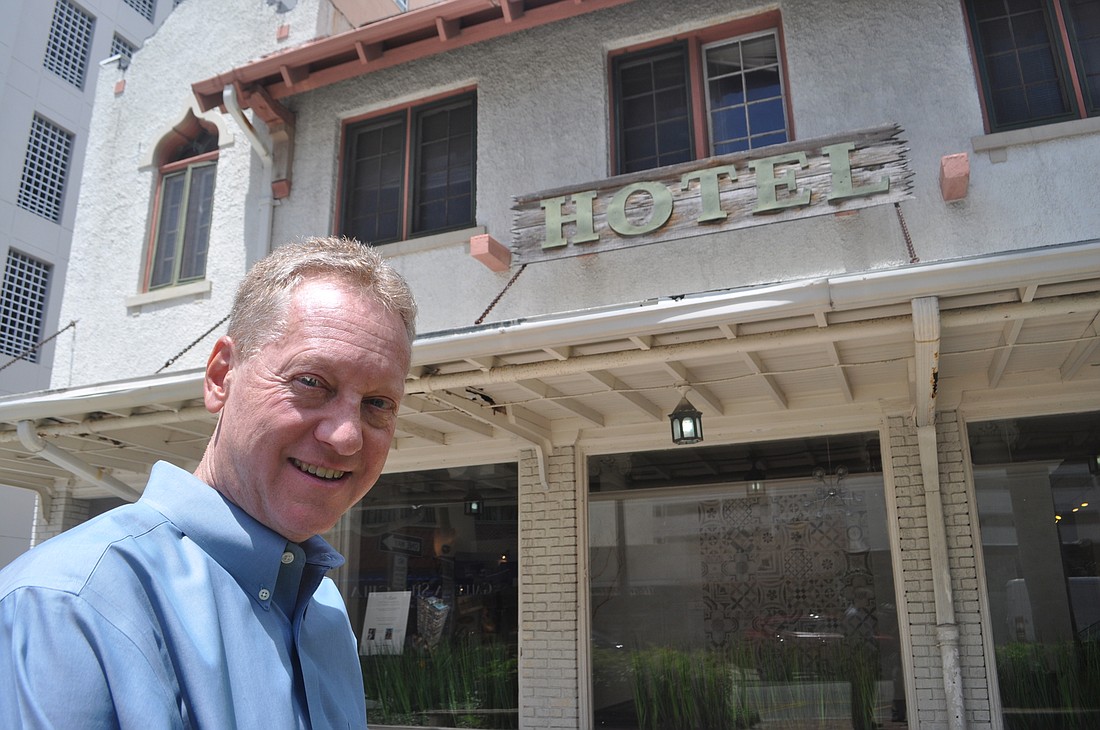- December 12, 2025
-
-
Loading

Loading

Examining a list of the city’s issues with his company’s proposal for an 18-story development on the site of a historic Palm Avenue building, Greg Kveton says he’s willing to take three inches off the height of the high-rise if it helps his project become a reality.
Kveton is the head of GK Development Inc., the team behind a proposed condominium and commercial project on the site of the historic DeMarcay Hotel and Roth Cigar Factory buildings. Following the 2014 acquisition of the land at 33 S. Palm Ave., developers have made numerous attempts to revise the project’s original site plan, approved in 2006 and set to expire Oct. 15.
So far, the city has passed on approving those changes. Tim Litchet, the city’s director of neighborhood and development services, cited six different criteria when he ruled the changes to the site plan would constitute a major, rather than a minor, revision. That would require the City Commission to sign off on the changes, a lengthy process that would likely blow past the Oct. 15 deadline to acquire a building permit.
The reasons for the city’s ruling vary. Litchet writes that, in the newer plans, the number of condos is reduced from 39 to 30, the architectural style is “much different” and the parking layout is changed. Even the height of the building — marginal as the difference may be — is listed as a factor in the decision.
"The total height of the structure is 247 feet, 1 inch, as opposed to the 246 feet, 10 inches approved," Litchet’s ruling states.
The 2006 site plan is a crucial factor in determining the future of the development. Approved under the now-defunct Downtown Residential Overlay District, the plan entitles the builders to more than four times as many residential units as they would get today.
Although it was initially unclear what impact the city’s ruling would have on the project, Kveton says he’s working on yet another revision to the site plan with the city. He’s willing to make certain changes. They’ll build 39 residential units; the layout of the condominium floors will be changed to reflect the initial plan; the height will come down to 246 feet, 10 inches.
He’s confident a workable solution will be reached before October. Still, he admits some points of disagreement with the city remain, and he’s hopeful staff will acquiesce to some changes he believes are less significant.
“Nine years has gone by since it was approved,” Kveton said. “There are some things that have changed. When that building was approved, as is the case with any building that’s being approved, it’s a very early schematic drawing of what is to be built.”
One of those disputed points has to do with the historic facades of the DeMarcay Hotel and Roth Cigar Factory, which are to be preserved, per the site plan. Kveton is fine with that requirement, but the original site plan called for the facades to be removed from their original location. When the revised site plan attempted to keep the facades in their existing location, the city pointed to that as another factor in its ruling.
Kveton said that requirement would require the builders to demolish and then reconstruct the facade — a process he’d like to avoid if at all possible.
“We do know from talking to a lot of people involved in preservation it’s not a good idea to move a facade like that, because it’s very difficult to move it,” Kveton said.
The historic nature of the properties in question have led to controversy, as some downtown leaders have called for the preservation of the buildings altogether. A lawsuit filed by the 1350 Main Residential Condominium Association, which argues the site plan should already be expired, is perhaps the last refuge for citizens who hope to halt the project completely.
City Commissioner Liz Alpert says she’s gotten feedback from constituents who want to save the DeMarcay Hotel and Roth Cigar Factory, but the approval of the site plan makes it difficult to intervene.
“If they meet all the requirements, there's not a lot we can do,” Alpert said.
Kveton is aware of the desire for historical preservation, but, beyond the facades, he says the age of the buildings makes them difficult to use in a practical manner. He’s trying to at least preserve the facades in their existing state, but if the city rules they must be moved, that won’t be a breaking point for the developer.
“We’re not going to stop the process on this project for the facades,” Kveton said.
Not everybody downtown is opposed to the proposal. Kveton said he’s received positive responses from merchants along Palm Avenue, who believe the project will bring activity to the street. Eileen Hampshire, owner of Art to Walk On, doesn’t see how adding a high-quality new project and more residences to the area could hurt, even if it’s not her first choice for the property.
“If I had Donald Trump’s money, I would buy the building. I would turn the cigar factory into a museum, and I would make the front area a nice boutique hotel or something,” Hampshire said. “But it’s not my building, and I didn’t buy it.”